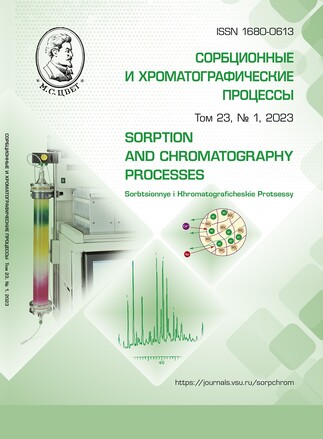Hydrogel coatings based on cellulose phosphate as a prolonged drug carrier
Abstract
The successful use of Miramistin as a bactericidal agent against aerobic and anaerobic bacteria, Gram-positive and Gram-negative microorganisms and monocultures stimulates the search for a non-toxic carrier and a prolongator of its action. The purpose of this study was the creation of a prolonged form of miramistin based on phosphorylated cellulose in the form of a gel-forming napkin, as well as the investigation of the interaction of cellulose phosphate with miramistin, the kinetics of drug release from the macromolecular compound phase. The choice of carrier polymer is due to such properties as low toxicity, biocompatibility, biodegradability, and high sorption capacity with respect to low- and high-molecular biologically active substances. Cellulose phosphate was obtained by esterification in orthophosphoric acid – phosphorus(V) oxide – tributyl phosphate system. The influence of the miramistin concentration in the initial solution on the degree of its inclusion in the composition of cellulose phosphate in the salt (Na-form) and hydrogen form, and the degree of swelling have been studied using IR spectroscopy and chromatographic analysis. It was established that the sorption isotherms of miramistin on cellulose phosphate are described by the stoichiometric local sorption equation. Based on the experimental data, the sorption parameters were calculated and a quantitative estimate of the sorption was obtained. In the area of initial concentration 0.3 10-3-1.4 10-3 M sorption of miramistin by cellulose phosphate proceeded predominantly by the cation exchange mechanism and was in the range of 22.0-109.8 mg/g. With a further increase in the miramistin concentration in the external solution, the contribution of non-exchange absorption increases, however, the limiting sorption capacity of cellulose phosphate with respect to miramistin composed a small fraction of the exchange capacity of the first stage (17%). A microfibrous porous napkin based on cellulose phosphate with the introduced miramistin was obtained, the kinetic curves of the release of miramistin from the cationite phase with an active substance content of 5.0 and 10.0 mg/g corresponding to a therapeutic dose are shown. It was established that the inclusion of miramistin in the composition of the salt form of cellulose phosphate led to a significant decrease in the release of the drug substance compared to the control solution. Under in vitro conditions kinetic curves have two sections: a rapid release of miramistin within an hour (up to 20%) and a long linear section. An analysis of the kinetic curves based on the Ritger-Peppas model demonstrated that the release of miramistin is performed by a diffusion mechanism.
Downloads
References
Chernysheva M.G., Popov A.G., Tashlitsky V.N., Badun G.A., Cationic surfactant coating nanodiamonds: Adsorption and peculiarities. Colloids and Surfaces A: Physicochemical and Engineering Aspects, 2019; 565: 25-29. https://doi.org/10.1016/j.colsurfa.2018.12.057
Chernetskaya Y.G., Belkovsraya Y.G., Trukhachova T.V., Zhebentyaev A.J., HPLC method development and validation for myramistin determination in hydrogel polymer matrixes. Vestnik farmacii. 2010; 49(3): 67-77. (In Russ.).
Park S.B., Lih E., Park K.S., Joung Y.K., Han D.K., Biopolymer-based func-tional composites for medical applications. Progress in Polymer Science. 2017; 68: 77-105. https://doi.org/10.1016/j.progpolymsci.2016.12.003
Ling S., Chen W., Fan Y., Zheng K., Jin K., Yu K., Buehler M.J., Kaplan D.L., Biopolymer nanofibrils: structure, model-ing, preparation, and applications. Progress in Polymer Science. 2018; 85: 1-56. https://doi.org/10.1016/j.progpolymsci.2018.06.004
Qureshi D., Nayak S.K., Maji S., Anis A., Kim D., Pal K., Environment sensitive hydrogels for drug delivery applications. European Polymer Journal. 2019; 120: 109220.https://doi.org/10.1016/j.eurpolymj.2019.109220
Ilgin P., Ozay H., Ozay O., A new dual stimuli responsive hydrogel: Modeling approaches for the prediction of drug load-ing and release profile. European Polymer Journal. 2019; 113: 244-253. https://doi.org/10.1016/j.eurpolymj.2019.02.003
Bezerra R.D.S., Morais A.I.S., Osajima J.A., Nunes L.C.C., Felho E.C.S., Development of new phosphated cellulose for application as an efficient biomaterial for the incorporation/release of amitriptyline. International Journal of Biological Macromolecules. 2016; 86: 362-375. https://doi.org/10.1016/j.ijbiomac.2016.01.063
Brkich L.L., Markin P.A., Moskaleva N.E., Pyatigorskaya N.V. Brkich A.V. Development and validation zhurnal. of the method for determining lidocain and miramistin in innovative wound. Khimiko-farmacevticheskii zhurnal. 2020; 54(1): 38-42. https://doi.org/10.30906/0023-1134 (In Russ.).
Brkich L.L., Pyatigorskaya N.V., Brkich G.E., Belov A.A., Krashyuk J.J. Miramistin as an antimicrobial component in the innovative substance of Chitosan-Miramistin Complex (CMC) for the treat-ment of infected wounds of various gene-sis. Journal of Pharmaceutical Sciences and Res. 2018; 10(8): 2027-2029. (In Russ.)
Yurkshtovich N.K., Golub N.V., Yurkshtovich T.L., Mironchik V.O., Alinovskaya V.A., Kinetics research of the process of phosphorylation of regenerated cellulose in the system phosphoric acid – tributyl phosphate – phosphorus oxide(V). J. Belarus state univ. chem. 2017; 1: 16-24. (In Russ.)
D.E.C. Phosphorus: chemistry, bi-ochemistry and technology. London, New York. Boca Raton, 2013, 1439 p.
Yurkshtovich T.L., Golub N.V., Solomevich S.О., Yurkshtovich N.K., By-chkovsky P.M., Kosterova R.I., Alinovskaya V.A. Effect of the composition of the esterifying mixture and the na-ture of the polysaccharide on the acidic properties of phosphoric acid cationites. Rus. J. Phys. Chem. 2019; 93(9): 1401-1409. (In Russ.)
Zarechensky V.M., Khoroshevsky Yu.M., Surov Yu.N., Mechanism of acid-base equilibria of phosphoric acid cationite CFP-12/0.8. Rus. J. Appl. Chem. 1989; 62(8): 1724-1727.







